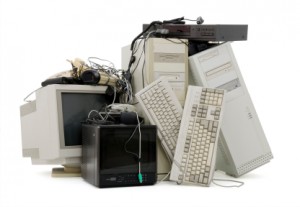Shopping at the second-hand server store


Back in the day, companies were pretty much tied to a particular manufacturer ( you were an IBM shop, or an NCR shop, or Honeywell or DEC, etc. ), and you bought ALL your hardware (and much of your software ) from them, like it or not. One of the Big Hammers they held over you was maintenance and repair - if you didn't have a service contract with them, you were at their mercy for both parts and labor, as well as at the bottom of their list for response time.
After some court cases, IBM was finally forced to accept used equipment purchased from third parties for service contracts (which included all parts and labor ), although they really didn't like to do it, as it meant losing a direct sale at full price.
I first did this about 30 years ago, when upgrading my employer's IBM System/ 3 to a (then new and cool ) System/ 34. IBM wanted $ 110,000 for the new box. I found the exact same specs on a used S/34 for $40,000, from a reseller on the other side of the country. This included shipping and installation, and "no money due until your local IBM branch gives you the letter certifying it for maintenance contract,", saving $70,000, or 63%. It required a big fight with my local IBM branch back then, but that's OK. Kinda fun, even.
Today, the "second hand server store" is as close as your computer, and the bargains are much better. Some sources to consider are Craig's List (where you'll find a lot of old dogs with fleas, and a very sporadic selection, but sometimes some great deals, as I mention below); eBay (also great for locating resellers that specialize in the particular gear you are looking for ); and a panoply of third party auction houses, aggregators and resellers of used gear. I won't mention any by name here, to avoid the appearance of endorsement, but simply Google "used Dell server", "used Proliant server", "used Cisco switch", etc, and they will gladly show you their wares. Many offer customized configurations, warranties of various durations, etc. Many have large warehouses of equipment ‘ready to configure to your spec and ship", and guaranties / warranties against DOA and early failure risks.
Some questions to consider: Changes to your basic architectural hardware choices?
How would it affect your backup / fail-over / redundancy strategy if the hardware needed to have twp identical boxes racked up side by side "live, wired, and ready to go" cost you less than half of what you thought you had to spend on one production box ? Not just "a spare hot-swap HD or power supply" or RAM chipset, but the ENTIRE box, configured, racked and wired?
What if this could be cost-justified both as "fall-back failure redundancy" AND "instant capacity upgrade if needed", at no additional cost? And used as processing power / storage space to facilitate backups or other tasks in the meantime ?
What if, for the price you thought you were going to have to pay for one server, you could get 4 or 5 of basically the same box, but one generation back -- 3 to 4 years old instead of "bleeding edge today", from the same manufacturer, with the same configuration? What are the implications of this for your strategies of virtualization, backups, fail-over, redundancy, etc? Even RAID configuration -- what if you had a transaction-current redundant backup server in the rack, wired and ready, and it cost you less than the RAID disk redundancy in ONE "new" server?
Certainly, there's an element of apples to oranges in these questions ( and in many aspects of this whole concept ), but IMO it does open up options and thought patterns that would not be realistic at full list price. Further, this article focuses only on one aspect / technique of saving money when equipping a server room. Questions such as virtualization, OS choices, software or hardware architecture in general, etc, are separate and distinct from the question of "Do we need the most expensive brand-new hardware we can find ? Or can we live with a 2.8Ghz clock speed instead of 3.2Ghz, 2 - 4 years old, for 1 / 5th of the cost ?", etc. This question is not in conflict with any of the other issues. They work rather well together, actually.
If one gets out of one's head the old shibboleths of "We must have the latest and greatest, and we must buy it brand new", and puts the business needs of the customer first, the calculus changes completely. Opening up to a new thought vector at the most basic physical layer, and thinking about customer/end user needs first, then how to best meet those needs cost-effectively can lead to huge cost savings.
Potential drawbacks: Yes, thinking outside the box always entails an element of risk!
There is an element of risk in this method (standing up to say "Let's consider an unconventional approach" can be risky), and more work effort may be required. You may have to spend more time and thought in your spec'ing / shopping, instead of just clicking through the manufacturer's website configuration wizard. You will likely have to buy (or acquire freeware versions of ) your OS and install it yourself.
You will have to know what you're doing, both in your shopping and in your installing. No hand-holding from the manufacturers, and you will have to deal with unforeseen issues yourself, etc. There may be some bumps in the road to deal with.
Is avoiding this risk worth spending five times as much money ?
Years ago, there was an industry truism "No one ever got fired for specifying new IBM equipment", and it probably holds true today, with an expanded list including Dell, HP, Cisco, etc. Then again, who ever got fired for saving their customer or employer 80% of an anticipated capital outlay, with no sacrifice (and perhaps even gains ) in performance or reliability?
Steps: First, make a list of things that actually matter, such as :
Solid reliable brand(s) of your choice (perhaps including IBM, Dell, HP, SUN, Cisco, etc) of known good construction and reliability, etc. (This article is not about going ‘white box', or playing ‘DIY Server Time'.)
Processing needs:
- Sockets/cores /speed
- Memory
- Disk
- Pipes / backbone / bandwidth ( busses, NIC's, etc )
- etc
Your choices / decisions on internals:
- SCSI vs. SATA ? ( look at cost and capacity options ! )
- RAID level ( if any )
- Redundant power supplies, NIC's, etc
- etc
Now, look at the used market in THOSE terms, not in terms of Dell's current new product line ( or whatever manufacturer you like ), but in terms of what you/your customer need - you can often buy whatever you want for ~ 20% of the cost of new. There are many big companies that refresh (replace ) their racks every three years or so, based on equipment coming off lease, capital projections, amortization schedules, etc, as well as the spare iron generated by mergers, take overs, buy-outs, etc, feeding the supply of used gear.
Examples: (For more examples and details, please click HERE.)
Recently, I bought a couple of Dell servers for a client from my local Craig's list - local companies that had bought out other companies, merged operations, consolidated computer rooms, and had extra bits to get rid of. In each case, they had 10 - 12 servers to sell. It pays to shop well ! I see today this same box on Ebay for $500 - $750!
Example - Dell SC1425 - $285 (originally ~ $ 2,500, new product from Dell in 2005.)
- 64 bit, 1u rack format
- 2 Processors - Dual socket 2.8 Ghz Xeons, 800 MHz front side bus
- 8 GB ECC DDR2 RAM
- 500 GB SATA HD
- 2 GB NIC's
Example - Dell SC1850 - $ 350 (originally ~ $ 3,500. )
- 64 bit, 1u rack format
- 2 Dual socket 3.2 Ghz Xeons
- 2 Dual hot swap power supplies
- 2 73 GB hot swap SCSI disks, onboard RAID
- 4 GB RAM
- 2 GB NIC'S
Example - $ 3,000 A two-year old Dell box with dual-socket quad-core 3.2 Ghz Xeon's and 32 GB RAM ( nice box for VM's ! ), SCSI RAID, redundant PS, etc. New equivalent - ??? 10 times that much ? Or 8 times that much?
Conclusion:
Discuss ahead of time with your customer or management whether or not this is worth an 80% savings in capital outlay. While depreciation / amortization schedules make the pain of capital outlay more bearable, nothing beats good old fashioned "get the same thing for a lot less money."
Any consultant or manager owes it to their client / employer to evaluate this option, lay out the pro's and con's as they may be in each case, and consider it from a price / performance viewpoint.